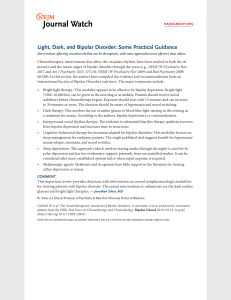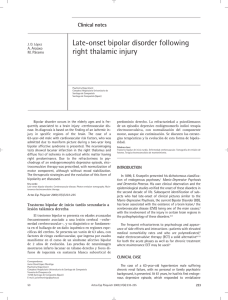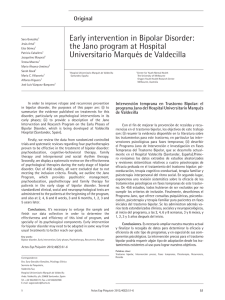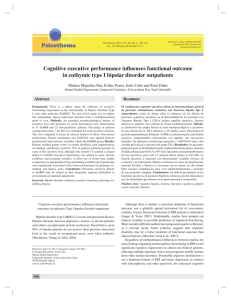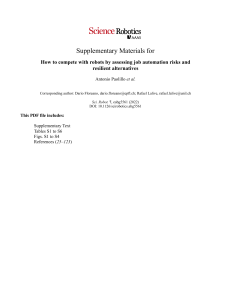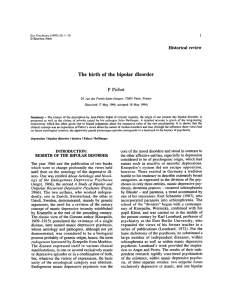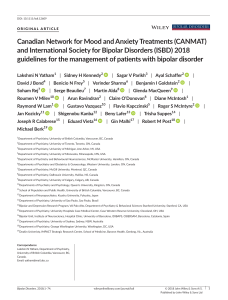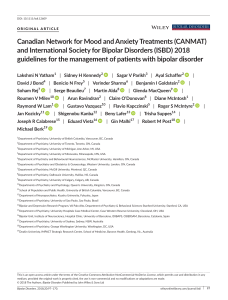Cost analysis of the adverse reactions of bipolar disorder treatment
Anuncio
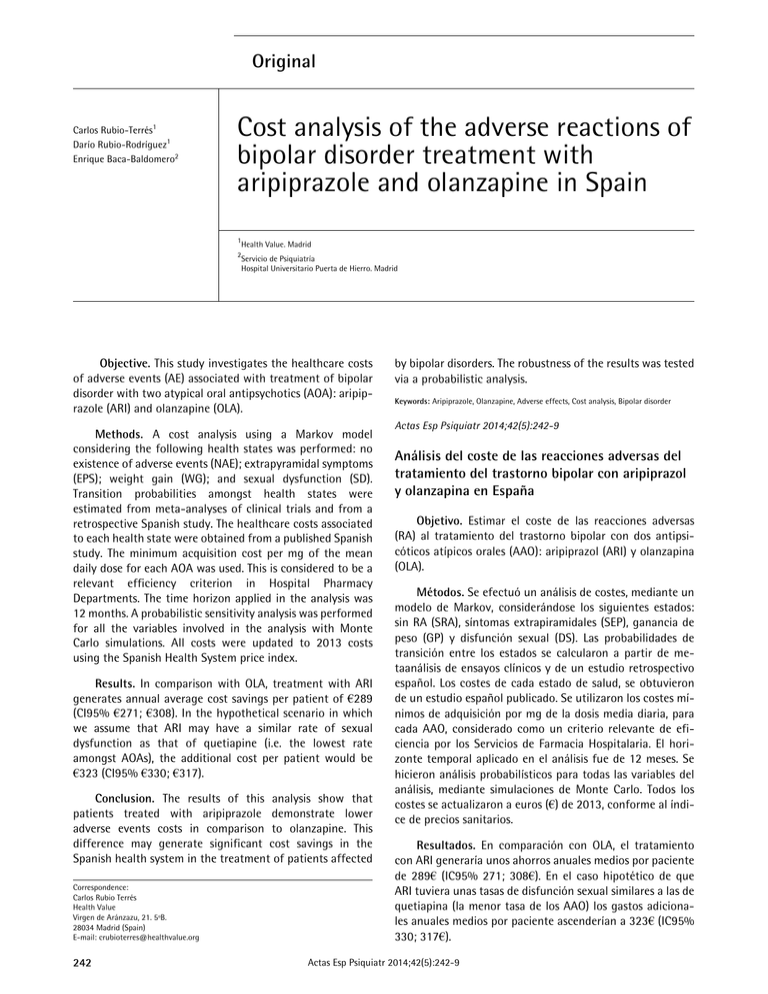
Original Carlos Rubio-Terrés1 Darío Rubio-Rodríguez1 Enrique Baca-Baldomero2 Cost analysis of the adverse reactions of bipolar disorder treatment with aripiprazole and olanzapine in Spain 1 Health Value. Madrid 2 Servicio de Psiquiatría Hospital Universitario Puerta de Hierro. Madrid Objective. This study investigates the healthcare costs of adverse events (AE) associated with treatment of bipolar disorder with two atypical oral antipsychotics (AOA): aripiprazole (ARI) and olanzapine (OLA). Methods. A cost analysis using a Markov model considering the following health states was performed: no existence of adverse events (NAE); extrapyramidal symptoms (EPS); weight gain (WG); and sexual dysfunction (SD). Transition probabilities amongst health states were estimated from meta-analyses of clinical trials and from a retrospective Spanish study. The healthcare costs associated to each health state were obtained from a published Spanish study. The minimum acquisition cost per mg of the mean daily dose for each AOA was used. This is considered to be a relevant efficiency criterion in Hospital Pharmacy Departments. The time horizon applied in the analysis was 12 months. A probabilistic sensitivity analysis was performed for all the variables involved in the analysis with Monte Carlo simulations. All costs were updated to 2013 costs using the Spanish Health System price index. Results. In comparison with OLA, treatment with ARI generates annual average cost savings per patient of €289 (CI95% €271; €308). In the hypothetical scenario in which we assume that ARI may have a similar rate of sexual dysfunction as that of quetiapine (i.e. the lowest rate amongst AOAs), the additional cost per patient would be €323 (CI95% €330; €317). Conclusion. The results of this analysis show that patients treated with aripiprazole demonstrate lower adverse events costs in comparison to olanzapine. This difference may generate significant cost savings in the Spanish health system in the treatment of patients affected Correspondence: Carlos Rubio Terrés Health Value Virgen de Aránzazu, 21. 5ºB. 28034 Madrid (Spain) E-mail: crubioterres@healthvalue.org 242 by bipolar disorders. The robustness of the results was tested via a probabilistic analysis. Keywords: Aripiprazole, Olanzapine, Adverse effects, Cost analysis, Bipolar disorder Actas Esp Psiquiatr 2014;42(5):242-9 Análisis del coste de las reacciones adversas del tratamiento del trastorno bipolar con aripiprazol y olanzapina en España Objetivo. Estimar el coste de las reacciones adversas (RA) al tratamiento del trastorno bipolar con dos antipsicóticos atípicos orales (AAO): aripiprazol (ARI) y olanzapina (OLA). Métodos. Se efectuó un análisis de costes, mediante un modelo de Markov, considerándose los siguientes estados: sin RA (SRA), síntomas extrapiramidales (SEP), ganancia de peso (GP) y disfunción sexual (DS). Las probabilidades de transición entre los estados se calcularon a partir de metaanálisis de ensayos clínicos y de un estudio retrospectivo español. Los costes de cada estado de salud, se obtuvieron de un estudio español publicado. Se utilizaron los costes mínimos de adquisición por mg de la dosis media diaria, para cada AAO, considerado como un criterio relevante de eficiencia por los Servicios de Farmacia Hospitalaria. El horizonte temporal aplicado en el análisis fue de 12 meses. Se hicieron análisis probabilísticos para todas las variables del análisis, mediante simulaciones de Monte Carlo. Todos los costes se actualizaron a euros (€) de 2013, conforme al índice de precios sanitarios. Resultados. En comparación con OLA, el tratamiento con ARI generaría unos ahorros anuales medios por paciente de 289€ (IC95% 271; 308€). En el caso hipotético de que ARI tuviera unas tasas de disfunción sexual similares a las de quetiapina (la menor tasa de los AAO) los gastos adicionales anuales medios por paciente ascenderían a 323€ (IC95% 330; 317€). Actas Esp Psiquiatr 2014;42(5):242-9 Carlos Rubio-Terrés, et al. Cost analysis of the adverse reactions of bipolar disorder treatment with aripiprazole and olanzapine in Spain Conclusión. Los resultados de este análisis muestran que los pacientes tratados con aripiprazol tienen menos reacciones adversas, en comparación con olanzapina. Esta diferencia puede generar ahorros significativos para el Sistema Nacional de Salud en el tratamiento del trastorno bipolar. La estabilidad de los resultados fue evaluada mediante análisis probabilísticos. Palabras Clave: Aripiprazol, Olanzapina, Efectos adversos, Análisis de costes, Trastorno bipolar INTRODUCTION Bipolar disorder, previously called manic-depressive psychosis, is a mood state disorder having a complex course. This makes the diagnosis, treatment and prognosis difficult. It is characterized by episodes going from depression to mania, including intermediate clinical forms (as hypomania). To establish the diagnosis, none of the episodes should be explained by medical, pharmacological, toxic causes or by other psychiatric conditions such as schizophrenia.1 There may be two types of bipolar disorder. The first is bipolar type I disorder in which at least one manic or mixed episode (mania accompanied by depression) has appeared in the clinical course. The second type is bipolar type II disorder. Here, the patient only has suffered major depressive episodes and at least one hypomanic episode (depression accompanied by mania).1 It is estimated that the prevalence of bipolar disorder in Europe is approximately 1%.2 Pharmacological treatment is an essential element in the management of patients with bipolar disorder.1-4 The principal drugs used in the treatment of bipolar disorder are mood stabilizers (principally lithium and antiepileptics), antidepressants and antipsychotics (typical and atypical).1 Several atypical oral antipsychotics (AOA) indicated in the treatment of bipolar disorder are currently available in Spain, such as olanzapine, quetiapine, risperidone and ziprasidone.5 Aripiprazole is an AOA with partial agonist activity on the D2 dopamine receptors,6 so that its pharmacological profile is different from that of other AOAs. The indication of aripiprazole was recently approved for the treatment of moderate or severe manic episodes in bipolar I disorder and in the prevention of new manic episodes in patients with predominantly manic episodes who responded to treatment with aripiprazole.7 Several meta-analyses that review the frequency of appearance of adverse reactions (AR) with the different AOAs have been published in recent years.8-10 Standing out among the ARs are extrapyramidal symptoms (as dystonia, parkinsonism, akatisia and dyskinesia), weight gain and sexual dysfunction due to their clinical impact.11,12 The clinical and economical consequences of ARs to the antipsychotics have been shown in two Spanish studies.11,12 Olanzapine is one of the AOAs most prescribed in Spain for the treatment of bipolar disorder13 with an annual cost attributable to AR (for its treatment, change of antipsychotics and hospitalization caused) that accounts for almost 70% of the total treatment cost.12 This study has aimed to calculate the cost of the AR to the treatment of bipolar disorder with two AOAs, aripiprazole (ARI) and olanzapine (OLA), in the National Health System. METHODS Patients The target population represents the hypothetical combination of patients in whom the theoretical analysis was performed and therefore is the population to which the study results can be applied. The target population of the analysis consisted of adult patients with bipolar type I disorder, treated with ARI or OLA.12,14 NAE Markov Model EPS WG SD SD: sexual dysfunction; WG: weight gain; EPS: extrapyramidal symptoms: NAE: no existence of adverse reactions Figure 1 Markov model of the adverse reactions from treatment of bipolar disorder with antipsychotics A pharmacoeconomic model of Markov15 was made with the states indicated in Figure 1: -- No existence of adverse reactions (NAE): this is the initial state in which the patients who initiate antipsychotic treatment do not initially have the ARs considered in the model. After, as the cycles develop (from 1 month of duration), the patients begin to suffer the ARs analyzed, so that they are moving into other states. Actas Esp Psiquiatr 2014;42(5):242-9 243 Carlos Rubio-Terrés, et al. Cost analysis of the adverse reactions of bipolar disorder treatment with aripiprazole and olanzapine in Spain -- Extrapyramidal symptoms (EPS): this state includes all the extrapyramidal ARs: akatisia, tremors, muscular stiffness, dystonia, EPS disorder, parkinsonism, dyskinesia and bradykinesia.10 -- Weight grain (WG): significant weight gain being understood as that greater than or equal to 7% of the patient’s initial weight.16 -- Sexual dysfunction (SD): it also includes other associated ARs with an increase of prolactin: gynecomastia, menorrhagia, amenorrhea and galactorrhea17. The model was elaborated with Microsoft Excel and TreeAge Pro. Transition probabilities Transition probabilities between the Markov states were obtained from a systematic review of the literature. This was specifically done from the meta-analysis of Edwards et al.9 that calculated the odds ratios of the ARs of ARI and OLA, among other antipsychotics compared with risperidone (RIS). The probability of remaining NAE in a monthly cycle in a patient treated with RIS was obtained from the systematic review of Derry et al.8 Appearance rates of EPS, WG and SD from the initial NAE were obtained from the systematic review of Gao et al.10 and two Spanish studies.16,17 The model considered that 41-47% of the patients did not adhere to treatment, for all causes, including the appearance of serious adverse reactions. Transition probabilities were calculated from the rates obtained in this way, using the formula proposed by Pettiti.18 Transition probabilities (TP) of the model are indicated in Table 1. Costs of the Markov states The direct health care costs of the Markov states, considering a 1 month cycle, was calculated according to the premises indicated in Table 2. Cost of the NAE state is limited to the pharmacological treatment cost with AOAs for the minimum cost possible per mg of active ingredient, considering that rationalizing the pharmaceutical cost is a priority of the Health Care System,19 and that 80% of the AOAs are sold in the Pharmacy (public sales price, including 4% VAT [PSPvat] with reduced price) and the remaining 20% are administered in the hospital (laboratory sales price [LSP]).20 The generic price of the medicinal product was used in the case of OLA. The daily doses and treatment duration observed in the Jing et al. study were used to establish the cost of the pharmacological treatment.21,22 This is a retrospective cohort study of the health care costs associated to bipolar disorder treatment with the principal AOAs in combination with mood 244 Table 1 Transition probabilities of the Markov model (in percentage, %). One month Cycle From To ARI OLA NAE NAE 68.79 32.47 NAE EPS 18.31 11.60 NAE WG 12.90 36.53 NAE SD 0.00 19.40 EPS EPS 17.59 5.14 EPS WG 12.41 16.17 EPS SD 0.00 8.59 EPS NAE 70.00 70.10 WG WG 12.41 16.17 WG SD 0.00 8.59 WG NAE 70.00 70.10 WG EPS 17.59 5.14 SD SD 0.00 8.59 SD NAE 70.00 70.10 SD EPS 17.59 5.14 SD WG 12.41 16.17 ARI: aripiprazole; SD: sexual dysfunction; WG: weight gain; OLA: olanzapine; EPS: extrapyramidal symptoms; NAE: no existence of adverse reactions stabilizers21,22 The study uses the propensity score methodology as a way of reducing selection bias and confusión.23,24 In all, 840 patients treated with ARI and 1101 treated with OLA who received a mood stabilizer for 30 days prior to the onset of the treatment with AOA were studied. The psychiatric health care costs during a 3-month (90 days) period were recorded. The cost of the EPS state was calculated by adding the specific cost of the AR to the already indicated cost of the drug treatment. This was calculated in accordance with the parameters obtained from the economic study of Bobes et al.12 The AR made it necessary: (i) to reduce the current dose in 11.5% (10-12%) of the patients affected, estimating that to reduce the dose, one unforeseen primary care medical visit is necessary, with a unit cost of 13.71€ (12.26-15.15€) obtained from the public prices of several Regional Communities;25-29 (ii) to add a concomitant treatment to control it, in 31% (27-35%) of the patients affected. Therefore, one unforeseen primary care medical visit would also be necessary, the treatment being biperiden (2-6 mg/ day).12 (iii) The ARs also made it necessary to change from AOA in 5% (4.5-5.5%) of the patients affected, with an additional visit to the doctor and an average cost of five frequently used antipsychotics (OLA, quetiapine, risperidone, Actas Esp Psiquiatr 2014;42(5):242-9 Carlos Rubio-Terrés, et al. Table 2 Cost analysis of the adverse reactions of bipolar disorder treatment with aripiprazole and olanzapine in Spain Principal premises of the cost analysis of adverse reactions of treatment of bipolar disorder with aripiprazole or olanzapine (2013€) Ítem Source 1. Cycle duration / Time frame: 1 month / 12 months - 2. It is considered that 80% of the AOAs are sold in Pharmacy ([PSPvat] with reduced price) and the remaining 20% are administered in the hospital (laboratory sales price [LSP]). 20 3. Minimum cost of acquisition per mg of the AOAs compared • Aripiprazole = 0.28 € • Olanzapine (generic medication)= 0.15 € 4. Consequences of an EPS episode • 1 extraordinary visit to the primary care physician in 47.5% (42.5-52.5%) of the patients • Reduction of the AOA dose in 11.5% (10-12%) of the patients • Concomitant treatment (biperiden, 2-6 mg/day): 31% (27-35%) of the patients • Change of AOA in 5% (4.5-5.5%) of the patients affected • Hospitalization of 25% (20-30%) of the patients who do not comply with the treatment (47%) 12 12 12 12 12,30,31 5. Consequences of a WG episode • 1 extraordinary visit to the primary care physician in 13.0% (11.7-14.3%) of the patients • Reduction of the AOA dose in 10.0% (9.0-11.0%) of the patients • Change of AOA in 3.0% (2.7-3.3%) of the patients affected • Hospitalization of 25% (20-30%) of the patients who do not comply with the treatment (41%) 12 12 12 12,30,31 6. Consequences of a SD episode • 1 extraordinary visit to the primary care physician in 32.0% (28.8-35.2%) of the patients • Reduction of the AOA dose in 26.0% (23.4-28.6%) of the patients • Change of AOA in 6.0% (5.4-6.6%) of the patients affected • Hospitalization of 25% (20-30%) of the patients who do not comply with the treatment (41%) 12 12 12 12,30,31 7. Duration of hospitalization due to the bipolar disorder (days)= 18.1 (14.5-21.7) 32 8. Cost of one day of hospitalization for bipolar disorder= 380.25 € (304.20-456.31 €) 32 9. Cost of an extraordinary visit to the PC physician= 13.71 € (12.26-15.15 €) Calculated 5,19,21,22 25-29 Table 1 10. Transition probabilities of the Markov Model AOA: atypical oral antipsychotic(s); PC: primary care; SD: sexual dysfunction; WG: weight gain; EPS: extrapyramidal symptoms; LSP: laboratory sales price; PSPvat: public sales price with reduced price plus 4% VAT; AR: adverse reaction. The values between brackets of the variables were used to perform the sensitivity analyses ziprasidone and haloperidol). Finally, (iv) it was considered that 47% of the patients do not adequately comply with the treatment due to the EPS, so that their bipolar disorder would be poorly controlled, estimating that 65% (±10%) of these must be hospitalized during a period of one year.12,30,31 A daily cost of hospitalization of 380.25€ was used and average duration of admission of 18.1 days, in agreement with the recent study of González-Pinto et al.32 (Table 2). Similar calculations were made to estimate the costs of the WG and SD states, based on the already indicated Spanish studies.12,32 In both cases (WG and SD), the treatment abandonment rate was estimated at 41% of the patients12,30,31 (Table 2). The costs of the Markov states (expressed in Euros [€] of the year 2013) are summarized in Table 3. Time frame of the study was 1 year. Probabilistic analyses Monte Carlo probabilistic analyses were made. These analyses evaluated the effect on the results of the simultaneous modification of several variables, within some plausible intervals and in accordance with previously defined statistical distributions using a high number of simulations. This type of analysis usually generates results that are Actas Esp Psiquiatr 2014;42(5):242-9 245 Carlos Rubio-Terrés, et al. Table 3 State Cost analysis of the adverse reactions of bipolar disorder treatment with aripiprazole and olanzapine in Spain Cost of the Markov states (2013€). One month cycle AOA Mean Minimum Maximum ARI 102.00 96.59 107.41 OLA 41.21 38.76 43.66 NAE EPS WG SD ARI 636.71 483.43 810.89 OLA 581.16 430.05 753.26 ARI 559.31 425.55 709.45 OLA 503.08 371.36 651.30 ARI 553.46 422.26 702.42 OLA 504.52 373.90 653.25 AOA: atypical oral antipsychotic; ARI: aripiprazole; SD: sexual dysfunction; WG: weight gain; OLA: olanzapine; EPS: extrapyramidal symptoms; NAE: no existence of adverse reactions between those obtained in the univariate deterministic analyses and the analysis of extreme scenarios, so that they may give rise to a more realistic estimation of the uncertainty.33-35 Simulations of modification of the variables involved were performed in agreement with normal statistical distributions.36,37 Each Monte Carlo analysis was made with 1000 simulations for each one of the 1000 patients used as a sample. A value of the above-mentioned variables was randomly assigned in each one of these (that represent a hypothetical patient). Modifications were made randomly, simultaneously, for the principal variables of the model: (i) the transition probabilities between the Markov states; and (ii) the costs of the Markov states. In the base case of analysis, it was considered that the rate of SD appearance would be equal to 0% for ARI, given that no Table 4 cases of SD related with ARI were detected in the Edwards et al. meta-analysis.9 Because the base case could be determined by the circumstances indicated, an analysis of sensitivity was carried out, hypothetically considering that the rate of SD with ARI was equal to the lower rate of SD described with AOA, specifically 17.22% observed with quetiapine.9 RESULTS In comparison with OLA, treatment with ARI would generate mean yearly savings per patient of 289€. These savings would occur in at least 95% of the simulations (95% CI 271; 308€) (Table 4, Figure 2). In the hypothetical case that ARI would have similar SD rates as those described in the AOA quetiapine, there would be an additional mean yearly cost per patients that would reach 323€ (95% CI 330; 317€) (Table 4). DISCUSSION In accordance with the present model, patients treated with ARI have fewer ARs in comparison with OLA. This difference may generate significant savings for the National Health System in the treatment of the bipolar disorder. Several premises were used in the study. In the first place, the transition probabilities between the Markov states were obtained from several systematic reviews and previously published meta-analyses8-10 and from two Spanish studies.16,17 To establish the pharmacological treatment cost, the daily doses and treatment duration observed in the Jing et al. study21,22 were used. Cost of the adverse reactions states (EPS, WG and SD) was calculated by adding to the cost Cost of adverse reactions of treatment of bipolar disorder with aripiprazole or olanzapine: Monte Carlo simulation (2013€). Time frame: 1 year Item ARI OLA Difference 3.344 3.633 -289 SD not described with ARI (*) Mean value Standard deviation 27 19 - LL of 95%CI 3.288 3.596 -308 UL of 95% CI 3.398 3.669 -271 3.958 3.635 323 SD with ARI equal to that observed with QUE (*) Mean value Standard deviation 23 19 - LL of 95%CI 3.914 3.597 317 UL of 95% CI 4.003 3.673 330 aripiprazole; SD: sexual dysfunction; 95% CI: 95% confidence interval; LL: lower limit; UP: upper limit; OLA: olanzapine; QUE: quetiapine. * Edwards et al.9 246 Actas Esp Psiquiatr 2014;42(5):242-9 Carlos Rubio-Terrés, et al. Cost analysis of the adverse reactions of bipolar disorder treatment with aripiprazole and olanzapine in Spain conservative given that it does not include the possible reduction of risk of hypercholesterolemia or diabetes with ARI in comparison with OLA in the model. Diference of costs Olanzapine vs Aripiprazole 0.090 The stability of the results was evaluated by probabilistic analyses that included variables of transition probabilities and costs of the states, confirming the saving with ARI with a 95% confidence interval. 0.080 0.070 Probability 0.060 0.050 0.040 0.030 0.020 0.010 0.000 €205 €230 € 255 €280 €305 €330 €355 €380 €405 Incremental Cost Figure 2 Cost of the adverse reactions of the treatment in a patient with bipolar disorder with aripiprazole or olanzapine: Monte Carlo simulation (2013€). The amounts indicate the savings that would be produced after one year of treatment with aripiprazole instead of olanzapine. Mean annual saving per patient with ARI would be 289€ (95% CI: 271€ to 308€) of the pharmacological treatment, the specific cost of the AR, calculated in accordance with the parameters obtained in the Spanish study of Bobes et al.12 The unit prices were obtained from the public prices of several Regional Communities25-29 and from a Spanish study published in 2009.32 Treatment cost with ARI is fundamentally lower because of its better tolerability compared with OLA, with lower probability of suffering any of the adverse reactions studied (32.2% and 67.5% with ARI and OLA, respectively). It stands out that although ARI has been associated with greater risk of akatisia compared with placebo38 this is generally milder and does not limit the treatment39 (Table 1). In a pragmatic type randomized clinical trial (Schizophrenia Trial of Aripiprazole, STAR), performed in 12 European countries, ARI was compared with the standard antipsychotic treatment (consisting of OLA, quetiapine or risperidone, in accordance with the psychiatrists participating in the study).40 The results showed that there was less impact with ARI on the metabolic risk factors (total cholesterol, LDL-cholesterol, triglycerides, serum prolactin fasting glucose and weight gain) at the end of 26 weeks of treatment compared with the standard treatment.40 The approach of the present study was The annual cost of ARs with OLA, obtained in the present study (3633€) is less than the theoretical cost (9484€, updated to the year 2013) estimated in the Bobes et al. study.12 This difference is due not only to the structural differences of the models compared but also the fact that the published model considered some annual resources not considered in this study: group therapy, follow-up medical visits, care in the day unit and laboratory tests. The principal limitation of this analysis is that the daily doses and treatment duration were not obtained from a Spanish study but from the retrospective United States of America study of Jing et al.21,22 However, this had two important virtues: its elevated sample size (6162 patients with bipolar disorder) and its design, using the propensity score methodology as a way of reducing the possible screening and confounding biases.23,24 In according with the objective criterion of rationalization of pharmaceutical cost, determined by the minimum acquisition cost, in comparison with OLA, treatment of bipolar disorder with ARI would generate some mean yearly savings per patient of 289€, with a 95% confidence interval (95% CI 271; 308€). The results of this study should be confirmed by a pragmatic type randomized clinical trial that would include the use of resources in Spanish patients with bipolar disorder treated with aripiprazole or olanzapine.41 Funding Study performed with research funding, without restrictions, from Otsuka Pharmaceutical. references 1. Dulanto R, Reza M, Blasco JA, Fernández de Larrea N. Estándares de uso adecuado de Tecnologías Sanitarias. Eficacia y seguridad del tratamiento farmacológico del trastorno bipolar. Madrid: Plan de Calidad para el SNS del MSC. Unidad de Evaluación de Tecnologías Sanitarias, Agencia Laín Entralgo; 2008. Informes de Evaluación de Tecnologías Sanitarias: UETS Nº 2006/02-04. 2. Fajutrao L, Locklear J, Priaulx J, Heyes A. A systematic review of the evidence of the burden of bipolar disorder in Europe. Clin Pract Epidemiol Mental Health. 2009:5:3. Actas Esp Psiquiatr 2014;42(5):242-9 247 Carlos Rubio-Terrés, et al. Cost analysis of the adverse reactions of bipolar disorder treatment with aripiprazole and olanzapine in Spain 3. Montoya A, Pérez J, Gilaberte I, González-Pinto A, Haro JM, Vieta E, et al. Patterns of drug treatment for manic episode in the clinical practice. Outcomes of the Spanish sample in the EMBLEM Study. Actas Esp Psiquiatr. 2007;35:315-22. 4. Bipolar affective disorder. A national clinical guideline. Scottish Intercollegiate Guidelines Network Nº 82. Edinburgh: SIGN, May 2005. 5. Base de datos de medicamentos. Consejo General de Colegios Oficiales de Farmacéuticos. Disponible en URL: http://www. portalfarma.com/home.nsf (consulta: marzo, 2013). 6. Lieberman JA. Dopamine partial agonists: a new class of antipsychotic. CNS Drugs. 2004;18:251–67. 7. Ficha técnica o Resumen de características del producto. Abilify (aripiprazol). Disponible en URL: http://www.ema.europa.eu/ humandocs/PDFs/EPAR/abilify/emea-combined-h471es. pdf (marzo de 2010). 8. Derry S, Moore RA. Atypical antypsichotics in bipolar disorder: systematic review of randomised trials. BMC Psychiatry. 2007;7(40). 9. Edwards SJ, Smith CJ. Tolerability of atypical antipsychotics in the treatment of adults with schizophrenia or bipolar disorder: a mixed treatment comparison of randomized controlled trials. Clin Ther. 2009;31:1345-9. 10. Gao K, Kemp DE, Ganocy SJ, Gajwani P, Xia G, Calabrese JR. Antipsychotic-induced extrapyramidal side effects in bipolar disorder and schizophrenia: a systematic review. J Clin Psychopharmacol. 2008;28:203-9. 11. Marazuela R, Rubio-Terrés C, Giner J, Jiménez FJ. Pharmacoeconomic analysis of the treatment of schizophrenia with quetiapine, olanzapine, risperidone or haloperidol in Spain. J Med Econ. 2006;9:27-45. 12. Bobes J, Cañas F, Rejas J, Mackell J. Economic consequences of the adverse reactions related with antipsychotics: an economic model comparing tolerability of ziprasidone, olanzapine, risperidone, and haloperidol in Spain. Progr Neuro-Psychopharm Biol Psych. 2004;28:1287-97. 13. Mercado nacional del grupo terapéutico N05A1 – Antipsicóticos atípicos. Ventas por unidades. Archivo de Bristol-Myers Squibb. Madrid, 2010. 14. Peiró S, Gómez G, Navarro M, Guadarrama I, Rejas J; Psychosp Group. Length of stay and antipsychotic treatment cost of patients with acute psychosis admitted to hospital. Description and associated factors. Psychiatr Epidemiol. 2004;39:507-13. 15. Rubio-Terrés C, Echevarría A. La herramienta clave: modelos de Markov. Pharmacoeconomics – Spanish Research Articles. 2006;3(Suppl 2):71-8. 16. Bobes J, Rejas J, García-García M, Rico-Villademoro F, GarcíaPortilla MP, Fernández I, et al; EIRE Study Group. Weight gain in patients with schizophrenia treated with risperidone, olanzapine, quetiapine or haloperidol: results of the EIRE study. Schizophr Res. 2003;62:77-88. 17. Bobes J, García-Portilla MP, Rejas J, Hernández G, GarcíaGarcía M, Rico-Villademoros F, et al. Frequency of sexual dysfunction and other reproductive side-effects in patients with schizophrenia treated with risperidone, olanzapine, quetiapine, or haloperidol: the results of the EIRE study. J Sex Marital Ther. 2003;29:125-47. 18. Pettiti DB. Meta-analysis, decision analysis and costeffectiveness analysis. Methods for quantitative synthesis in medicine. New York: Oxford University Press, 1994. 19. Agencia Estatal de Evaluación de las Políticas Públicas y la Calidad de los Servicios. Incidencia de las medidas adoptadas para la racionalización del gasto farmacéutico. Madrid: Ministerio de Administraciones Públicas, Noviembre de 2007. 248 20. Adaptación del estudio de impacto presupuestario de la entrada de Abilify para el tratamiento de pacientes con trastorno bipolar en España. Archivo de Bristol-Myers Squibb, 1 de septiembre de 2008. 21. Jing Y, Kim E, You M, Pikalov A, Tran Q-V. Healthcare costs associated with treatment of bipolar disorder using a mood stabilizer plus adjunctive aripiprazole, quetiapine, risperidone, olanzapine or ziprasidone. Journal of Medical Economics. 2009;12:104-13. 22. Kim E, Pikalov A, Ammerman D, Knoth R. Second-generation antipsychotics and hospitalization in bipolar disorder: a claim data analysis. World Psychiatry. 2009;8(Suppl 1):190. 23. Rosenbaum PR, Rubin DB. The central role of the propensity score in observational studies for causal effects. Biometrika. 1983;70:41-55. 24. Expósito M, Ruiz M, Pérez S, Garrido P. Uso de la metodología propensity score en la investigación sanitaria. Rev Clin Esp. 2008;208:358-60. 25. Orden de 14 de octubre de 2005, por la que se fijan los precios públicos de los servicios sanitarios prestados por Centros dependientes del Sistema Sanitario. BOJA Núm. 210, Sevilla 27 de octubre de 2005: 46-83. 26. Decreto 34/2006 de 19 de abril, por el que se establecen los precios públicos por la prestación de los servicios y actividades de naturaleza sanitaria de los de Salud del Principado de Asturias. Boletín Oficial del Principado de Asturias, Nº 105, 9 de mayo de 2006: 9353-8. 27. Orden del consejero de Salud y Consumo, de 11 de septiembre de 2008, de modificación de la Orden del consejera de Salud y Consumo de 22 de diciembre de precios públicos que han de aplicar los centros sanitarios de la Red pública de las Islas Baleares por la prestación de servicios sanitarios cuando haya terceros sin derecho a la asistencia sanitaria de la Seguridad Social. Boletín Oficial de las Islas Baleares Nº 131, 18 de septiembre de 2008: 37. 28. Orden SAN/8/2007, de 4 de abril, por la que se fijan las cuantías de los precios públicos de los servicios sanitarios prestados por el Servicio Cántabro de Salud Boletín Oficial de Cantabria Nº 74, 16 de abril de 2008: 4915. 29. Resolución de 14-02-2008, del Sescam, sobre precios a aplicar por sus centros sanitarios a terceros obligados al pago o a los usuarios sin derecho a asistencia sanitaria. DOCM Nº 46, Fasc. I, 29 de febrero de 2008: 5793. 30. Hogarty GE. Prevention of relapse in chronic schizophrenic patients. J Clin Psychiatry. 1993;54(Suppl):S18–S23. 31. Goldstein MJ. Psychoeducational and family therapy in relapse prevention. Acta Psychiatr Scand. 1994;382(Suppl):S54–S57. 32. Gonzalez-Pinto AM, Dardennes R, de Zélicourt M, López P, Oliveros RG, Vieta E, et al. In-patient care costs of patients with bipolar I disorder: A comparison between two European centers. J Affect Disord. 2009 May 30. [Epub ahead of print]. 33. Rubio-Terrés C, Cobo E, Sacristán JA, Prieto L, del Llano J, Badia X, por el Grupo ECOMED. Análisis de la incertidumbre en las evaluaciones económicas de intervenciones sanitarias. Med Clín (Barc). 2004;122:668-74. 34. Briggs AH, Gray AM. Handling uncertainty in economic evaluations of healthcare interventions. BMJ. 1999;319:635-8. 35. Manning WG, Fryback DG, Weinstein MC. Reflecting uncertainty in cost-effectiveness analysis. In: Gold MR, Siegel JE, Russell LB, Weinstein MC, eds. Cost-effectiveness in health and medicine. New York: Oxford University Press, 1996; pp 247-75. 36. Pertegaz S, Pita S. La distribución normal. Cad Aten primaria 2001; 8: 268-74. Disponible en URL: http://www.fisterra.com/ mbe/investiga/distr_normal/distr_normal2.pdf (consulta: abril Actas Esp Psiquiatr 2014;42(5):242-9 Carlos Rubio-Terrés, et al. Cost analysis of the adverse reactions of bipolar disorder treatment with aripiprazole and olanzapine in Spain de 2010). 37. Glaser R. Monte Carlo simulation of scenario probability distributions. Livermore: Lawrence Livermore National Laboratory-University of California, October 23, 1996. 38. Gao K, Kemp DE, Fein E, Wang Z, Fang Y, Ganocy SJ, et al. Number needed to treat to harm for discontinuation due to adverse events in the treatment of bipolar depression, major depressive disorder, and generalized anxiety disorder with atypical antipsychotics. J Clin Psychiatry. 2011;72:1063-71. 39. McIntyre RS, Yoon J, Jerrell JM, Liauw SS. Aripiprazole for the maintenance treatment of bipolar disorder: a review of available evidence. Neuropsychiatr Dis Treat. 2011;7:319-23. 40. Kerwin R, Millet B, Herman E, Banki CM, Lublin H, Pans M, et al. A multicentre, randomized, naturalistic, open-label study between aripiprazole and standard of care in the management of community-treated schizophrenic patients Schizophrenia Trial of Aripiprazole: (STAR) study. Eur Psychiatry. 2007;22:43343. 41. Rubio Terrés C. Pharmacoeconomic analysis in new drug development: a pragmatic approach to efficiency studies. Clin Res Reg Aff. 1998;15:209-23. Actas Esp Psiquiatr 2014;42(5):242-9 249
